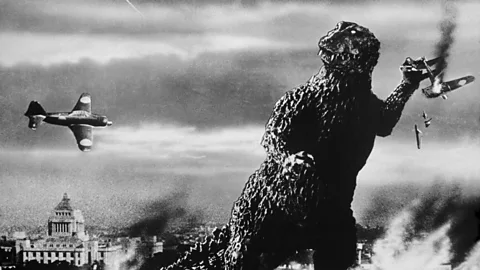 Alamy
AlamyIshirō Honda’s momentous 1954 monster film was born out of a national tragedy in Japan. It has a bleak message for humanity that goes beyond cinematic spectacle.
For some, Godzilla is the pink-finned superhero who teams up with an axe-wielding King Kong in this year’s Godzilla x Kong: The New Empire. Others may remember it as a kindly guardian angel with laser-beam eyes and a cute nephew named Godzooky in the 1970s Hanna-Barbera cartoon series. But it started life as a very different beast. When Godzilla first reared up from the boiling ocean in 1954, it was the pitiless embodiment of nuclear devastation in a Japanese film that still stands, 70 years on, as the darkest and most sombre monster movie ever made.
To mark the anniversary, Alex Davidson curated a season of kaiju films (Japanese giant monster movies) at the Barbican Centre in London earlier this year. “The first one I saw was Ebirah, Horror of the Deep, from 1966, which has Godzilla battling a giant shrimp,” Davidson tells the BBC. “I absolutely loved it – but the version I saw on Channel 4 in the 1990s had a terrible [English language] dub, and Godzilla is presented as this quite benevolent, already existing creature. It’s a lot of fun, but it isn’t necessarily the most serious film in the world. The following year, Channel 4 showed the first Godzilla in the original Japanese, and it was such a shock to see a film that is so beautiful and haunting and bleak.”
According to kaiju lore, Godzilla is a prehistoric monster, but most fans would agree that it was born in August 1945, when US atomic bombs detonated over the Japanese cities of Hiroshima and Nagasaki, killing more than 150,000 people. “It’s important for us to remember that Japan is the only nation on Earth to have directly suffered an atomic bombardment,” Steven Sloss, a leading kaiju scholar, tells the BBC. “That’s why, with what it explores, Godzilla is a film that only Japan could have made.”
The bombs had a “great, great impact on the Japanese national psyche”, adds Sloss – but the people of Hiroshima and Nagasaki weren’t the last Japanese citizens to be killed by an atomic blast. In March 1954, a tuna fishing boat named Daigo Fukuryū Maru, or Lucky Dragon Five, was contaminated by fallout from a US thermonuclear test at Bikini Atoll in the Pacific Ocean. The crew’s radio operator died of radiation sickness, and the Japanese government discovered that irradiated tuna was being sold all around the country. Dr Jeffrey Angles, a professor at Western Michigan University, discussed the issue in a seminar hosted by the Barbican and the Japanese Foundation London. “It became very clear to the Japanese population that, almost regardless of what they did, radiation that was being created from forces outside of Japan was going to come back home and visit them.”
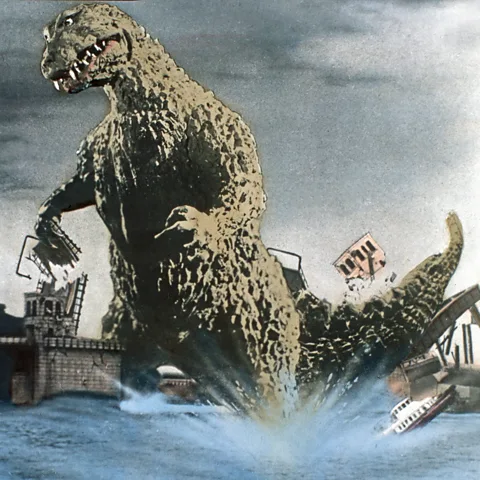 Getty Images
Getty ImagesIt was Tomoyuki Tanaka, a producer at Toho studios, who had the idea to combine this real-life horror with an outsized monster, having been inspired by two recent cinema hits. King Kong (1933) had been reissued in 1952, and a new film about a rampaging dinosaur in modern-day New York, The Beast From 20,000 Fathoms, came out in 1953. Tanaka hired a prolific science-fiction novelist, Shigeru Kayama, to write a treatment for the so-called “Project G”. “He really conceived of [it] as an anti-nuclear project,” says Dr Angles, who translated Kayama’s novelisation of the story into English.
The rest of the crew took the production just as seriously, including Ishirō Honda, its director and co-writer, and Eiji Tsuburaya, who supervised the design and visual effects. Almost incredibly, Godzilla was in cinemas just eight months after the Lucky Dragon Five incident – and, to establish that the film would be weightier than the average monster movie, it opens with a scene recreating that traumatic event.
The making of a monster
The story is that Godzilla (or Gojira, to use its more phonetically accurate Japanese name) is a Tyrannosaur-like dinosaur, a member of a species that has remained hidden in the ocean for the past few millennia – most of the time, anyway. “When it can’t find fish in the sea, it comes to the land to prey on men,” says a village elder on the island where it is sometimes seen. But it has now been disturbed by atomic bomb tests which have mutated it into a near-indestructible Leviathan, and given it “radioactive breath”. Understandably, they have also given it a bad temper. Godzilla is soon laying waste to Tokyo, knocking down buildings with a swish of its tail, and setting the city ablaze.
The film-makers had wanted to imitate the exquisite stop-motion animation that Willis H O’Brien had created for King Kong, but Tsuburaya didn’t have the time or the budget required, hence Godzilla is played by Haruo Nakajima in a rubber suit with pudgy legs and wobbly dorsal fins. He plods through a miniature model city, and there are just a few snippets of animation and puppetry, but the scenes of the monster trampling the Japanese capital are still terrifyingly effective – and far more upsetting than the equivalent New York scenes in King Kong.
Honda had been held as a prisoner of war in China in 1945, and had seen the ruins of Hiroshima first hand on his way home. He was determined to recreate the apocalyptic carnage and the subsequent smoking desolation that so many Japanese people remembered from 1945, not just in Hiroshima and Nagasaki, but also in Tokyo, which had been razed by US firebombing raids. “A lot of people who went to the theatre to see [Godzilla] as adults broke into tears while watching it,” says Dr Angles. “The film provided a method for people to get in touch with and re-feel some of the old traumas that were still with them from World War Two.”
A key factor is the attention the film pays to the monster’s innocent victims. The most distressing sequence has a mother hugging her children as they cower in the street. “You can see your father soon,” she says. “We’ll join him in heaven.” Soon afterwards, there is a documentary-like naturalism to the sombre scenes of an overcrowded hospital, its corridors lined with stretcher bearers, blood-streaked corpses and crying infants. A doctor holds a Geiger counter up to one small girl and shakes his head as the device crackles: no hope.
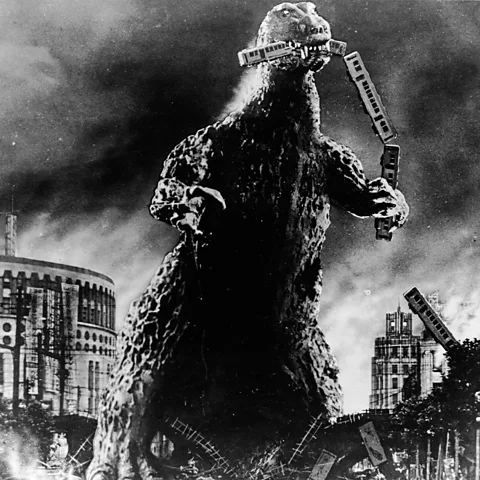 Getty Images
Getty Images“The original film is very, very special,” says Sloss. “You can compare it to The Beast From 20,000 Fathoms, because they both have a highly radioactive, prehistoric reptilian monster, they’re both black and white, and shot in 4:3 ratio. But they’re only similar on a superficial level. The Beast From 20,000 Fathoms was made for the Saturday matinee crowd – for kids and teenagers. It isn’t sad or tragic. But the extended scenes of suffering in Godzilla are heartrending.”
The film has other depths that are beyond most monster movies, too. One of its main characters is Dr Yamane (Takashi Shimura, the co-star of such Kurosawa classics as Rashomon and Seven Samurai), a palaeontologist who is shown sitting in darkness, dismayed at the prospect of such a miraculous “biophysical specimen” being killed rather than studied. Another character is an eye-patched rogue scientist, Dr Serizawa (Akihiko Hirata), who has synthesised a substance he calls the “oxygen destroyer”, which can reduce marine life to skeletons in seconds when it is introduced to water. Serizawa knows that it could work on Godzilla, but he is afraid that if the government gets its hands on the formula, the substance will be weaponised and cause even greater harm.
A Pyrrhic victory
Godzilla isn’t just a spectacular blockbuster, then – although it’s certainly that – but a parable about a terrible dilemma: should we allow ourselves to develop more and more powerful weaponry, knowing that this escalation will lead to ever higher numbers of casualties? Ultimately, Serizawa is persuaded to use the oxygen destroyer, but he burns his notes beforehand, and kills himself afterwards while mournful music plays. “We’re not invited to say, ‘Hurrah, this is going to save the day,’” says Davidson. “The oxygen destroyer is a lesser evil than Godzilla, but it’s still a last resort.” The film-makers slot in some bitter irony, as a reporter crows about “a great victory for Dr Serizawa”. But considering that it hinges on a gloomy sacrifice, the defeat of Godzilla is a long way from the kind of victory you might see in a Hollywood film.
“It’s not a victory at all,” says Sloss. “There’s the lingering threat of Pandora’s Box having been opened. In some ways, the end of Godzilla is similar to the end of Christopher Nolan’s Oppenheimer, when Oppenheimer says to Einstein, ‘We were worried that we’d start a chain reaction that would destroy the entire world… I believe we did.’ The message is that the arms race is never-ending, there’s always going to be a bigger threat around the corner, we’re always facing our own annihilation, and it will be at our own hands.” Dr Yamane spells out this warning in the film’s final words: “I don’t think that was the only Godzilla. If they keep experimenting with deadly weapons, another Godzilla might appear, somewhere in the world.”
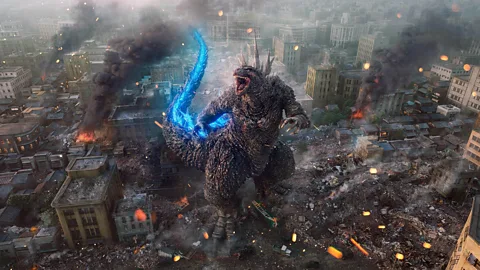 Alamy
AlamySure enough, a sequel was released just five months later, and they’ve kept on coming ever since: so far, there have been 33 Japanese Godzilla films, and while it’s fair to say that none of them is as momentous as the 1954 original, both Sloss and Davidson stress that they are all worth seeing in their own right. “The series becomes a lot more knowing and playful,” says Davidson, “but they’re very inventive. Even the weaker of the films, even if they have, say, a giant cockroach waddling about, and it looks absurd, at least they’re interesting and different and taking bold risks.”
Sloss believes that the Japanese Godzilla series is “one of the most tonally rich franchises in the history of popular cinema”, while Godzilla itself is “a very allegorically fluid character” who was created to comment on nuclear weaponry, but who went on to represent “the fight back against pollution, climate change, rampant consumerism and capitalism” and more. It’s tricky to say what Godzilla is supposed to represent in its recent Hollywood blockbusters, but his latest Japanese outings, Shin Godzilla (2016) and Godzilla Minus One (2023) – which won an Oscar for its special effects – come closest to the tone of the original. Or maybe, as Sloss suggests, it’s Oppenheimer that’s the first film’s true spiritual sequel. When Godzilla wreaks havoc in Tokyo, viewers might recall Oppenheimer’s quotation from the Hindu scripture Bhagavad Gita. “Now I am become Death, the destroyer of worlds.”
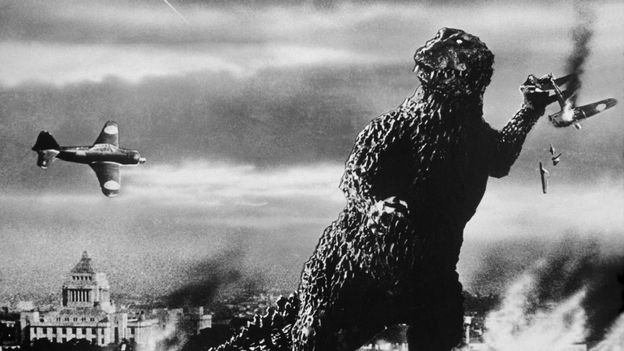


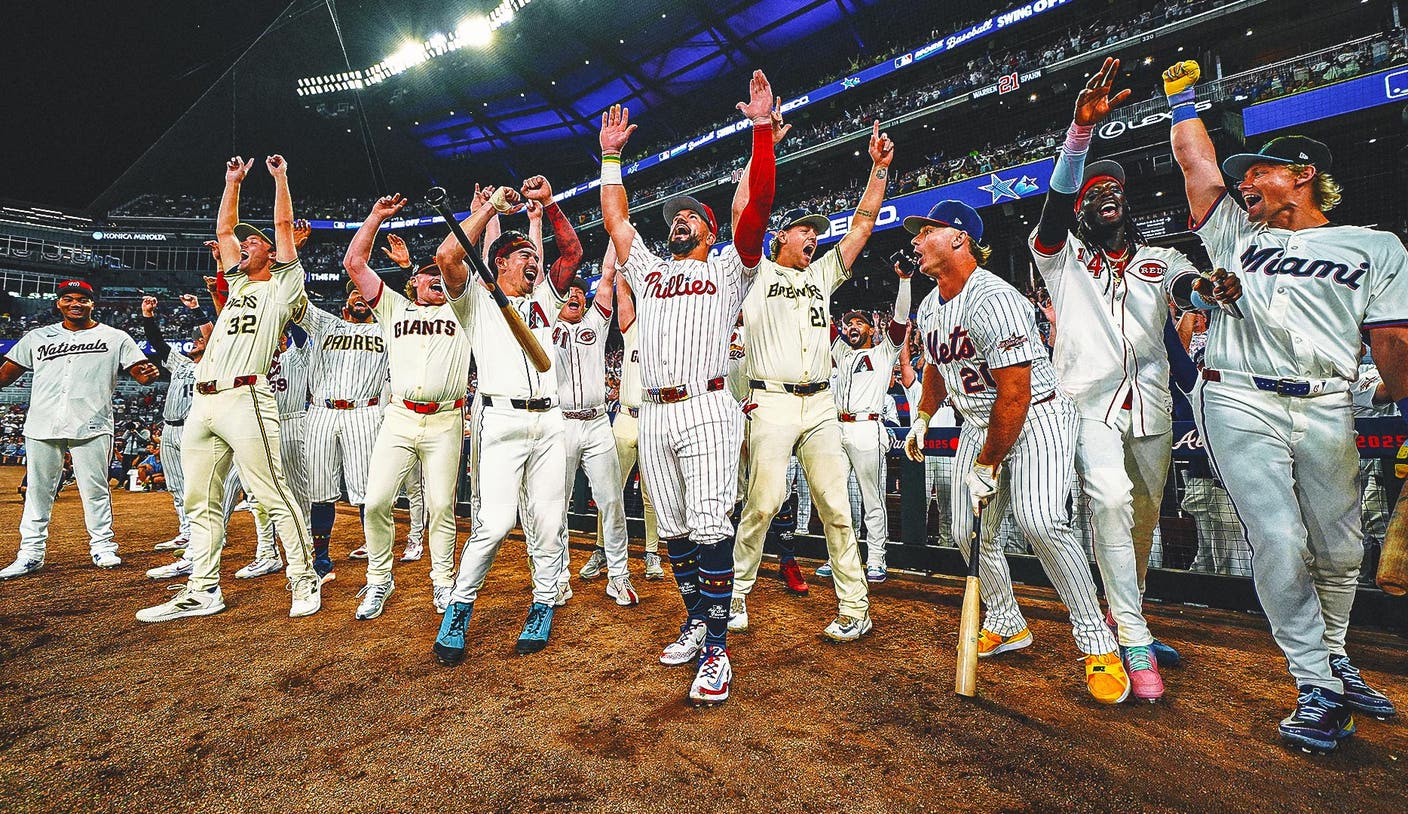
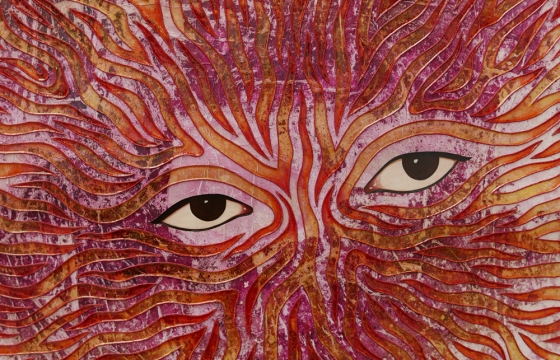


Leave a Reply